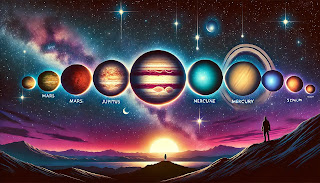Seven Planets Visible in the Night Sky: A Once-in-a-Generation Event
Skywatchers are in for a breathtaking celestial event this week as seven planets—Mars, Jupiter, Uranus, Venus, Neptune, Mercury, and Saturn—align in a rare “planetary parade.” This stunning display will not occur again with such clarity until 2040. Here’s everything you need to know, ranked by importance for skywatching.
1. Best Time to View the Planetary Parade
The prime viewing window for this event is just after sunset from Tuesday to Friday. However, time is limited—Mercury and Saturn will be visible for only a few minutes before they sink below the horizon. For the best experience, head to a location with an unobstructed horizon and minimal light pollution.
2. Which Planets Can You See Without a Telescope?
Of the seven planets, four—Mercury, Venus, Mars, and Jupiter—can be seen with the naked eye. Venus and Jupiter will be the easiest to spot due to their brightness, while Mars will appear as a reddish dot. Saturn will be more challenging, as it stays close to the horizon.
3. Why This Event Is So Rare
While planetary alignments are not unheard of, having seven planets visible at the same time is a rare treat. This occurs because the planets orbit in roughly the same plane as Earth, and at times they appear to form a line from our perspective. The next similar event won't happen until 2040.
4. Viewing Tips for the Best Experience
- Find a dark-sky location away from city lights.
- Give your eyes time to adjust—avoid looking at phone screens for at least 30 minutes.
- Use binoculars or a telescope to spot Uranus and Neptune, which won’t be visible to the naked eye.
- Look low on the horizon early to catch Mercury and Saturn before they set.
5. Weather Conditions and Best Viewing Nights
- Wednesday: Some cloud cover and showery rain may interfere with visibility.
- Thursday: Clearer skies expected, but mist and fog may develop later in the night.
- Friday: Best night for viewing, with clear spells after sunset before fog potentially sets in.
6. The Science Behind the Alignment
Even though the planets appear to be lined up, they are actually separated by millions of miles in space. Their orbits bring them into alignment from Earth’s perspective, creating a dazzling but purely visual phenomenon.
7. Capture the Moment
Astronomers encourage enthusiasts to take photos and document the event, as the next chance won’t come for another 16 years. If you manage to capture the planets, you can share your images with space enthusiasts worldwide.
This week presents a rare opportunity to witness the mechanics of our solar system in action—so find a good spot, look up, and enjoy the show!

